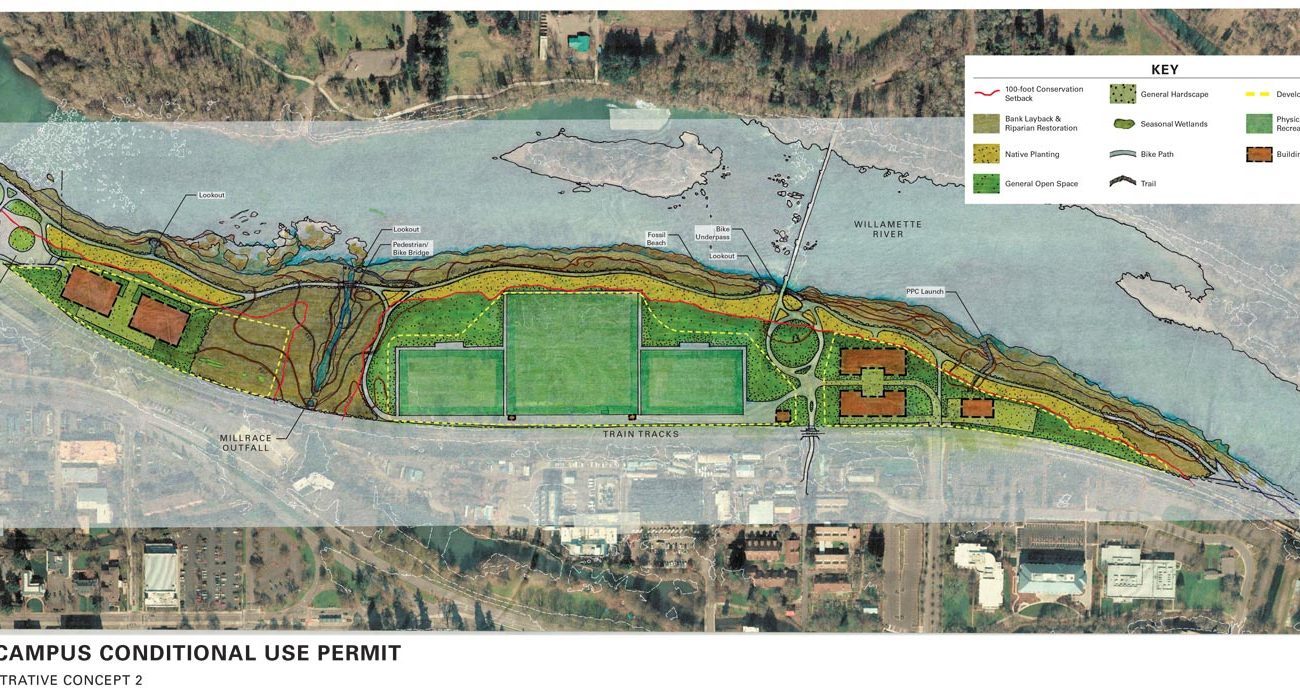A debate is growing around the future of the riverfront near the University of Oregon campus: Keep the land as is, develop it as an extension of the University of Oregon campus, or focus on environmental and habitat restoration.
The UO is seeking a conditional use permit from the city of Eugene for future developments along the Willamette River near the Frohnmayer Footbridge. University representatives say they plan to send the proposal to the city at the end of January, but numerous stakeholders have come forward in opposition to the proposal.
Allen Hancock is a Eugene resident concerned about the project. “This whole area is precious,” he says. “It’s our backyard, and sometimes you don’t realize that your backyard is world class. But the Willamette River is really a world class river.”
The UO proposal spans from Franklin Boulevard to 100 or 200 feet from the bank of the river and from the Frohnmayer Footbridge to UO’s property line with EWEB, where a bike path from 6th Avenue cuts between two chain link fences toward the river.
The permit plan is a bit vague to allow for future changes to the development, but includes a few buildings near the 6th Avenue bike path and near the Frohnmayer Footbridge, numerous buildings between Franklin Boulevard and the train tracks, and synthetic turf fields lit by floodlights near the footbridge.
Emily Eng, a senior planner for University of Oregon and the project manager for the North Campus Conditional Use Permit Project, says the plan does not guarantee that these projects will happen. “When you see a building footprint here it doesn’t mean that there’s building here, it means that we are asking for permission for that to be a possibility, so what this is showing is that this is the maximum footprint,” she says. “We don’t have any plans for that now.”
Eng says that the development is “basically extending the university campus across Franklin” and says the project would make the area “feel more park-like, I would think.”
“This green area over here would be restored riparian area by the Willamette,” she says. “We’d lay back the bank to a more natural slope, get rid of all the invasive plants to replace them with natives; there would be soft walking paths, seating areas for contemplating, resting, and there would be an improved bike path, and there would be outdoor recreation.”
Hancock, who previously organized against other developments in the area north of the railroad tracks in 2010 to 2011, isn’t so sure it would feel like a park with these developments. He’s concerned about “acres of synthetic fields with the runoff and the volatile emissions with the sun striking on it. There’ll be fences to secure who can use it, so it will be a very harsh environment very close to the river.”
The current fields in that location are often too soggy to use in winter and are a common resting place for geese. “It’s a riparian zone there, so that’s why there’s geese there,” Hancock says. “There’s a grassy field, and geese love grassy fields.”
Hancock got involved once he realized that proposed buildings could cut off a more effective bike path linking Alder Street to the river park system. “An innovative university will find a place, will find a way, to put the fields somewhere else.”
George Evans, a UO professor of economics, says he moved to Eugene partially for the river, and so he opposes developments close to the sensitive area.
“I think it should combine, ideally, some academic use,” he says, “habitat, and just protecting an environmentally sensitive area for the experience of the people who walk, bike or ride along that path. And restoring some of the land to a more natural environment would be great.”
Evans says buildings would ruin the capacity to restore the whole area to a more natural environment. “Once you put buildings on it, it’s very hard to take them off,” he says.
“Nobody is arguing that this is pristine land that’s never been touched. The question is can it be restored to something wonderful.”
Eng says she has received general support regarding the project. “The community seems excited about facilitating active uses in the area and increasing safety,” Eng says. “Active recreational fields, an improved bike path, and limited buildings north of the tracks, along with riparian restoration, are seen as positive.”
Eng says the proposal takes environmental concerns into account. “If the university found the need to build new recreational fields, it would explore design measures to address the impacts of the fields on the environment and wild life, such as stormwater treatment, no-infill or alternative infill options if using artificial turf, designing field lights for minimal light spillage, and limiting the operating hours for lights,” Eng says.
She also adds that important habitats — vernal pools — near the Millrace outfall would be protected under the current plan. A 100- to 200-foot buffer area from the riverbanks would be restored to native planting, she says, adding that most of the proposed construction is focused behind the train tracks, where many university buildings already exist.
“We have limited land, we have limited resources,” and the university wishes to preserve the campus’s high-quality open spaces, she says.
People who wish to comment on the proposal can find more information at cpfm.uoregon.edu/north-campus-conditional-use-permit and can send comments by email to Emily Eng, eeng@uoregon.edu.
